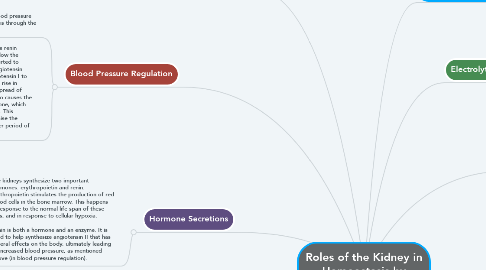Roles of the Kidney in Homeostasis by Gagandeep Grewal
by Gagandeep Grewal

1. Blood Pressure Regulation
1.1. The kidneys act to regulate blood pressure over the long-term. They do this through the renin-angiotensin system.
1.2. The kidney synthesizes and releases renin when the blood pressure drops below the normal range. Angiotensin is converted to Angiotensin I by the Renin. The Angiotensin Converting Enzyme converts Angiotensin I to II. The impact of Angiotensin II is a rise in blood pressure by causing a widespread of vasoconstriction. Angiotensin II also causes the adrenal cortex to release Aldosterone, which causes the reabsorption of sodium. This reabsorption of sodium helps to raise the blood pressure and last for a longer period of time.
2. Hormone Secretions
2.1. The kidneys synthesize two important hormones: erythropoietin and renin. Erythropoietin stimulates the production of red blood cells in the bone marrow. This happens in response to the normal life span of these cells, and in response to cellular hypoxia. Renin is both a hormone and an enzyme. It is used to help synthesize angiotensin II that has several effects on the body, ultimately leading to increased blood pressure, as mentioned above (in blood pressure regulation).
3. Regulation of pH
3.1. Through the regulation of ions, the kidneys prevent blood plasma from becoming too acidic or basic.
4. References Kidneys. (n.d.). Retrieved from https://mcb.berkeley.edu/courses/mcb135e/kidneys.html The role of the kidneys in homeostasis ? WJEC - Revision 2 - GCSE Biology (Single Science). (n.d.). Retrieved from https://www.bbc.com/bitesize/guides/zgh2xsg/revision/2
5. Acid-Base Balance
5.1. The kidney does this by recovering and regenerating bicarbonate (HCO3–) from urine and excreting hydrogen ions (H+) into the urine. The kidneys use the enzyme carbonic anhydrase to speed up the reactions involving HCO3-. It is important that our body pH remains within the range of 7.35-7.45.
6. Electrolyte Concentration
6.1. Some of the electrolytes the kidney helps to keep in homeostasis are sodium, potassium, chloride, bicarbonate, and phosphate. As mentioned in the "Blood Pressure Regulation" bubble, the hormones aldosterone and angiotensin II regulate the reabsorption of sodium from the renal filtrate and the excretion of sodium into the renal collecting tubule, respectively.
7. Removal of Toxic Waste
7.1. The nephron regulates the level of water, and salts and removes urea from the blood.
7.2. 1. Blood is brought to the kidney in the renal artery which branches off the aorta. 2. The kidney regulates/controls the water and salt content and removes urea. 3. The filtered excess water, salts and urea form a liquid called urine. 4. The urine is transported to the bladder along tubes called ureters. 5. The bladder stores the urine until it is convenient to expel it from the body through the urethra. 6. The purified blood returns to the circulation through the renal vein and to the heart through the vena cava.
8. Erythropoiesis
8.1. EPO stimulates the development of Red Blood Cells (RBC) in the Bone Marrow. Therefore, increasing the production of EPO wil help in manufacturing more RBC's.


